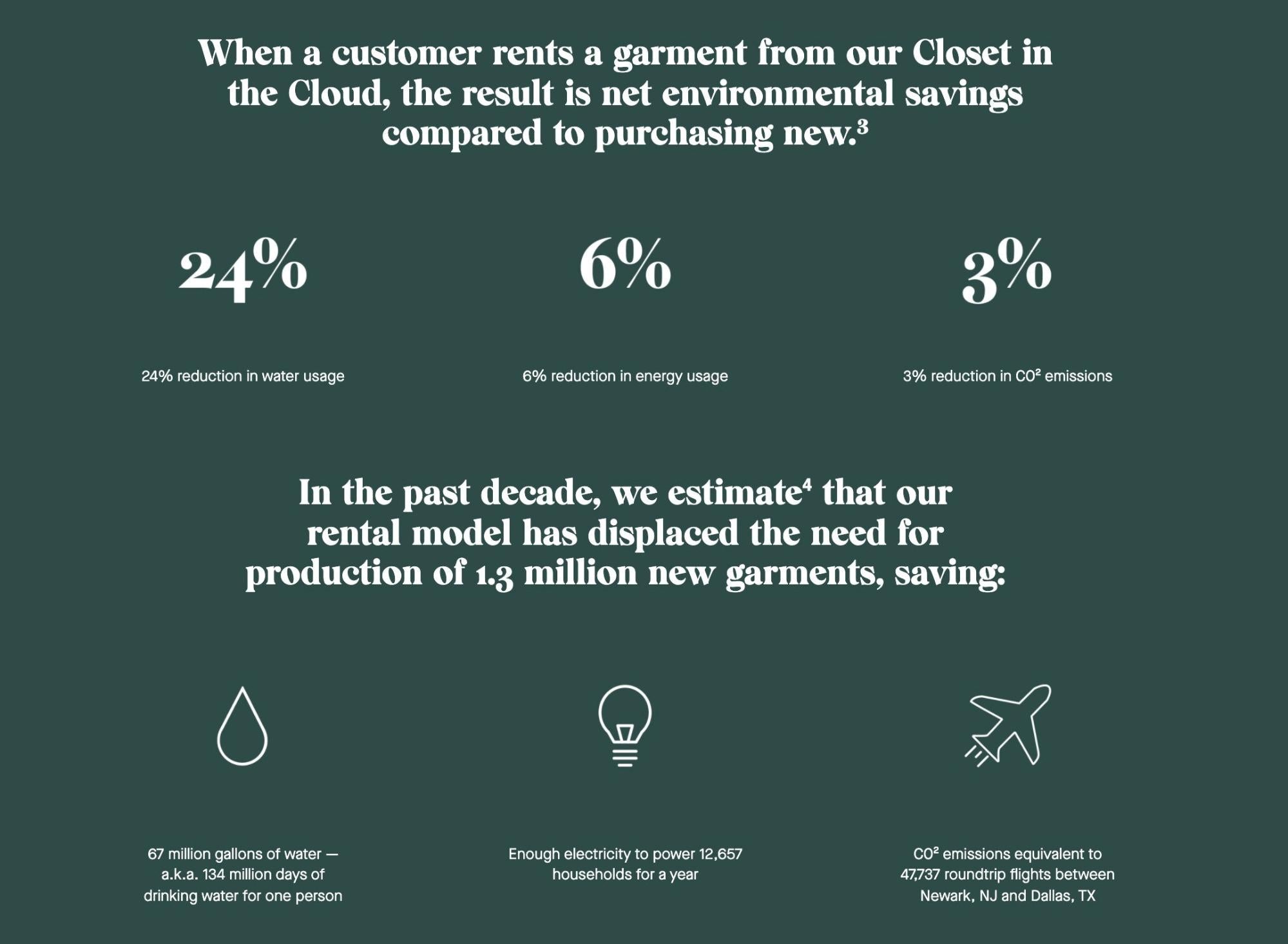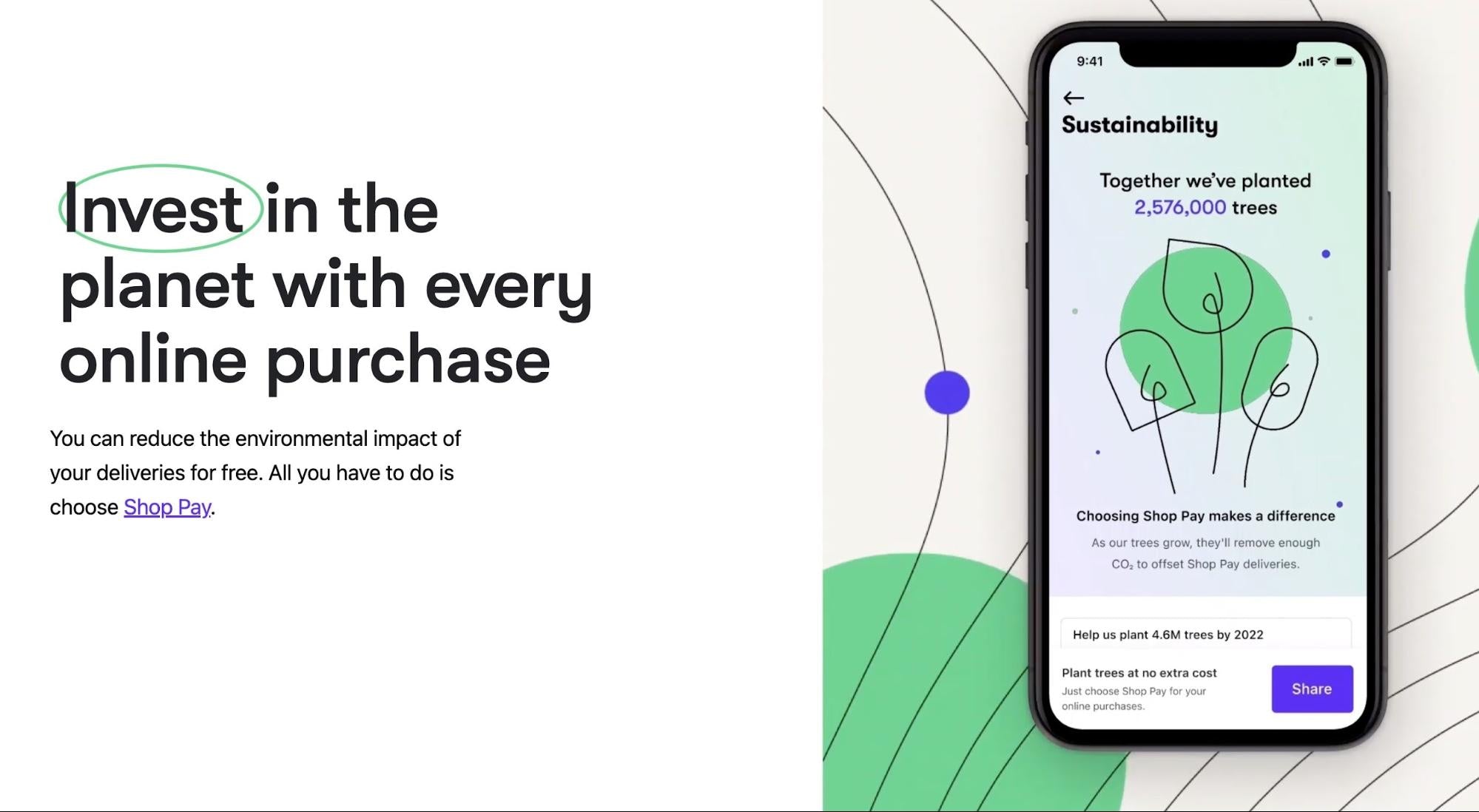The message is clear: more and more consumers around the world opt to buy from brands that are prioritizing sustainable retail.
In fact, nearly50% of consumersglobally are choosing to buy from brands with a clear commitment to sustainable retail. Many customers are happy to invest insustainable retailers, but going green is about more than just conserving energy or using longer-lasting light bulbs. Sustainability gives you an opportunity to better connect with your customers, and while having a zero net energy store might not be within grasp just yet, there are smaller steps you can take.
That’s why we’re covering sustainableretail trendsand their importance, how to make your retail business more sustainable, and real-life examples of brands that are achieving sustainability success.
Let’s get started.
Table of Contents
The importance of sustainable retail: stats and trends
Not sure if it’s worth investing in a more sustainable retail store?
Introducing sustainability into your retail business is not a requirement. Nowadays, however, if you want to reduce the negative impact on the environmentandattract and retain the growing number of consumers and employees who are socially conscious, taking steps to make your retail business more sustainable is crucial.
According to Deloitte:
- 73% of consumer industry CXOsincreased investments in sustainability in the past year.
- 84% of leaders agreethe world can achieve global economic growth while also reaching climate change goals and50% of companiesare developing new climate-friendly products or services.
Last year, Forrester released itsinaugural environmental sustainability Predictions report, and the trends are clear to see:
- Five Fortune Global 200 companies are likely to lead the way by announcing policies that limit travel in order to be more sustainable.
- Carbon offsets and credits will play a big part in business, but with less fraud.
- Carbon reporting will be governed by one universal standard.
There’s a moral imperative to these changes, but there’s also a business imperative. Consumers are driving businesses toward sustainable change, and if your business isn’t promoting a genuine sustainable retail agenda, consumers will find a business that does:
- IRi states that93% of consumersmaintained or increased their sustainable purchase habits over the past year.
- According toNYU Stern, sustainable products hold a 17% market share, and products marketed as sustainable grew 2.7 times faster than those not marketed as such.
- Loyalty increases too, according to McKinsey and Company, with products making sustainability claims on more than half of their products enjoying a32% to 34% repeat buying ratein comparison to a less than 30% repeat rate for those who don’t.
It’s not just consumers: According to Esker,76% of US employeessay sustainability in the workplace is more important than ever, clearly showing why sustainable retail is important at every level of your business, includingemployee retention.
How to develop a more sustainable retail business
Wanting to develop a more sustainable retail business and actually achieving sustainability are two different things. However, here are some actionable strategies for making your retail business more sustainable:
- Go paperless
- Cut waste out of your manufacturing process
- Look for clean energy options
- Recycle old goods
- Be transparent
- Source sustainable brands and products
- 探索租赁business model
- Use refurbished or recycled materials for in-store displays and décor
- Sell second-hand or set up a buy-back program
- Upcycle or donate unsold stock or samples
- Reduce waste and costs with digital showrooming and sample making
- Find ways to reduce your carbon footprint in shipping and logistics
- Invest in recyclable, compostable, or reusable product packaging and shipping supplies
- Give customers the option to choose carbon-neutral shipping options
- Set sustainability goals and stick to them
Let's take a close look at each of these sustainability-driven initiatives.
1. Go paperless

If your business consumes a lot of paper, one of the easiest ways to cut back is by emailing receipts. Not only will you save resources, your customers will likely appreciate having one less piece of paper to handle. According toThe World Counts, there are 420 million tons of paper and cardboard produced each year, and more than five million acres of forest are cut down in an average month.
Eliminating paper receipts not only helps reduce a business’s carbon footprint, it ensures that receipts aren’t later discarded as waste.
Going paperless can create efficiencies, help you automate more of your business processes, and offer your customers better security. Transitioning to digital receipts is a great first step toward going paper-free. It also allows you to use the valuable real estate on digital receipts to make more sales. Include links to your website and social media platforms on your receipts, plus news about upcoming events and promotions.
Receipts aren’t the only way to save paper. Rather than using paper calendars, try using a digital calendar tool likeCalendlyor one of theShopify appointment booking appsto schedule appointments with clients and maintain employee schedules. Sign up for paper-free statements for your banking and financial needs, and send invoices via email to your customers. You’ll be surprised how little effort it takes to reduce your paper consumption.
FURTHER READING:For more information on going paperless, read our article detailingall the benefits of going paper-free.
2. Cut waste out of your manufacturing process
Customers care about how their products are made and they want to know that you care, too.
Manufacturing can produce a lot of waste, and you can make a move toward sustainability by monitoring your retail supply chain.
If you make any of your own goods, audit your waste and look for ways to use recyclable or reusable products in the manufacturing process. If you purchase and resell premade goods, ask for transparency from your vendors about issues like labor practices, safety conditions, pollution, and waste. There are no industry standards on disclosure, so it’s up to you to be proactive when obtaining this information.
3. Look for clean energy options
In addition to reducing physical consumption, consider switching to less wasteful energy consumption. Here’s an area where going green helps you save serious money. Energy costs are continuing to rise, with the Bureau of Labor Statistics showing that the average electricity bill rose from14.7¢ per kilowatt hour in July 2022 to 16.8¢ per kilowatt hourin July 2023.
Contact your utility suppliers and ask that they conduct energy audits on your store, suggesting ways you can lower usage. A quick way to get started is to switch to LED light bulbs, which use less power. You can also look into solar options for powering lights and other electronics.
Lowering your thermostat seven to 10 degrees Fahrenheit for eight hours a day reduces consumption by 10%, according to the US Department of Energy.
Turn off your computer, copier, and printerwhen you leave for the day. And be sure to get your employees on board with your energy mission, appointing a “green team” or energy advocate to monitor usage. Simple behavioral changes provide no- or low-cost energy savings opportunities.
FURTHER READING:For more ideas about saving energy, read our list of ways togo green in your retail business.
4. Recycle old goods
In addition to selling customers new items, look for ways you can help them recycle old or worn-out goods.
For example, Eileen Fisher stores feature aRenewproject that collects, repairs, and resells used company-brand clothing and donates the proceeds to nonprofit organizations that benefit women and children.
Outdoor brand North Face has aRenewed Take-Backscheme, which collects used clothing and gives customers $10 off a purchase. Items are repurposed into products like insulation, carpet padding, stuffing for toys, and fibers for new clothing.
Nike’sReuse-A-Shoe(one of its manysustainable retail initiatives) collects used shoes that are recycled into material used to create running tracks, playgrounds, and courts.
If your business sells items that replace old goods, consider offering to collect items that can be repurposed or donated to someone who can use them.
5. Be transparent
可持续性的增长importance to consumers, so be sure to share your mission and work with your customers.
You’re not just tooting your own horn: you’re giving customers an opportunity to further their own sustainability efforts by supporting a business that cares about the environment, community, and future.
6. Source sustainable brands and products
If you stock various brands in your retail store, one way to make your business more sustainable is to buy only products from brands that follow sustainable business practices.
For example, when orders are shipped to your store, do they come in recyclable packaging? Do the brands tell you about their goals to reduce environmental impact and waste? Are the materials or ingredients used to make products sustainable? These are great questions to ask before you decide to stock a new brand.
7. Explore the rental business model
时尚等服务Rent the RunwayandNuulylet customers rent merchandise from a range of brands, leading to less consumption and waste, and reduced negative environmental impact.
Shoppers canpick a planor sign up for aclothing rental subscriptionto have a certain number of products delivered each month. When they’re done, they can send them back and choose another set of products or (depending on the business) skip a month.
Here you can see the environmental savings Rent the Runway has achieved with its rental business model.

8. Use refurbished or recycled materials for in-store displays and décor
Rather than buying all newproduct displaysor in-store decorations, consider buying second-hand or vintage, or fixtures made from recycled materials. Whatever you can do to reduce, reuse, refurbish, repair, and recycle will contribute to sustainability in retail.
9. Sell second-hand or set up a buy-back program
Second-hand, resale, or vintage products are popular among conscious consumers for two main reasons. Buying pre-used clothing means the environmental impact of the purchase is lower, and second-hand clothing is generally more affordable. Shoppers can feel good about their purchase and buy products they might have not been able to afford new.
The second-hand business model doesn’t make sense for all retailers, but even if you’re not a second-hand retailer, there might be ways you can incorporate thissustainable retail strategyinto your business.
For example, set up a buy-back program in which you accept returns on previously purchased items to be resold, repaired, or recycled into new products. You can also collaborate withresale platformsto sell buy-back items second-hand.
10. Upcycle or donate unsold stock or samples
Creative reuse, or upcycling, is when you transform waste materials, byproducts, or unwanted merchandise into new materials or products. It reduces textile and cloth waste by repurposing gently used fabric or deadstock.
Next time you have leftover fabric, samples, or stock, rather than dumping it, look into ways to upcycle it. Whether it’s reused to create new products you sell in your store or sold or donated to another company that can repurpose it into completely new products, upcycling helps reduce waste.
For example, when I had aclothing brand, at the end of each season, I had rolls of deadstock fabric and sales samples left and no use for them. Overbuying some materials is inevitable, but instead of dumping the fabric and samples, I donated them toMaterials for the Arts, a creative reuse center, where they were repurposed into costumes for theater companies.
11. Reduce waste and costs with digital showrooming and sample making
Retailers and brands in the fashion, home design, and beauty industries usedigital showroomsto make the sales and buying process easier for everyone.
Rather than scheduling buying appointments in your physical showroom or at trade shows, with virtual showroom software, brands can showcase their collections and retail buyers can visit at their convenience and place orders, all within one platform. And, depending on the digital showroom service provider, brands can create virtual or 3D samples to sell from.
This is a more sustainable and cost-effective option for several reasons:
- It reduces waste and expenses caused by the overproduction of samples and fabric.
- It minimizes the carbon footprint and environmental impact of making physical samples and shipping them from the factory.
- It eliminates the need for travel to and from buying appointments.
12. Find ways to reduce your carbon footprint in shipping and logistics
McKinsey and Company found that products making sustainability-related claims accounted for 56% of all growth over the past five years. With transportation accounting for14% of the global greenhouse gas emissions, according to Gitnux, finding ways to reduce your carbon footprint in shipping and logistics will help the environment and your revenue streams.
Your business could reduce its carbon footprint by changing last-mile deliveries to electric vehicles, scooters, or bicycles, and using parcel lockers or third-party logistics (3PL) centers to improve the sustainability of order fulfillment.
Download The Future of Shipping and Logistics Report
We’ve collected global, data-backed insights from hundreds of businesses and thousands of consumers to get the full picture of what’s in store for 2023, as well as the strategies and products your business needs to succeed over the next year.
Get the report13. Invest in recyclable, compostable, or reusable product packaging and shipping supplies
Every year, the ecommerce packaging market produces approximately10 million tons of CO2 equivalent. Considering 60% of respondents to McKinsey and Company said they’d pay more for a product with sustainable packaging, it’s important to reflect on how you can make your product wrapping recyclable, compostable, or reusable.
But the environmental impact is bigger than consumer demand.
Product packaging is the main source of ecommerce emissions. It’s five times higher than purchasing products in-store.
To implement this tip, start looking into recyclable or compostable shipping supplies and reusable product packaging.
14. Give customers the option to choose carbon-neutral shipping options
Offering carbon neutral shipping options is another great way to build sustainability into your retail store.
Empowering your customers to select these options at checkout helps them feel like they are part of your sustainability efforts by choosing the environmentally friendly shipping option.
For example,Shop Paywill help communities plant trees with every checkout to offset the environmental impact of shipping.

These types of programs can have a positive impact on the environment and your conversions.
More apps that enable carbon neutral shipping:
15. Set sustainability goals and stick to them
Use a few of the recommendations above to build a sustainable retail strategy, then communicate your goals internally to your team and externally to prospective and existing customers. This will help hold your business accountable, and can also influence a shopper’s decision to purchase from your store.
Keep your messaging simple, and communicate your sustainability progress with customers.
Examples of sustainable retailers
Ganni uses innovative materials in-store and upcycles unsold stock
As part of conscious fashion brandGanni’s环保责任努力,努力o use sustainable materials for its in-store displays and decor. This includes recycled plastic podiums, product displays, seats made from scrap plastic leftovers, second-hand stools, upcycled single-use plastic containers, and zero-waste wood flooring.

The brand also doesn’t let any stock go to waste. Itupcycles unsold clothingby partnering withSOEX, a recycling company in Germany, to recycle materials for reuse.
Reformation aims for greener retail stores
Popular LA-basedsustainable fashionbrand Reformation sells clothes that are both eco-conscious and trendy. But it’s also making an impact on the environment with itsGreen Business certified sustainable retail stores. There are six total in Platform, Melrose, Vintage Melrose, Santa Monica, Fillmore, and Valencia.

零售商使用策略来提高能源干腊肠ings, water efficiency, resource stewardship, and reduce CO2 emissions. Some of this includes using LED lights and recycled fabric insulation to save energy. It also calculates its construction footprint, and aims to offset store builds.
Levi’s extends the life of its products with repairs, recycling, and its SecondHand program
Levi’s is minimizing its environmental impact not only by educating customers about the benefits of using their clothes longer (wearing a garment for just nine months longer canshrink its carbon footprint by 30%), it’s also helping customers extend the life of their Levi’s clothes by repairing and recycling clothes at the company’sTailor Shop.

Additionally, in 2020, Levi’s launched its first buy back program, called Levi’s SecondHand. Customers can give back their jackets and jeans at retail stores inexchange for a gift cardthat can be used to buy second-hand jackets and jeans on Levi’ssecond hand marketplace.
Kiehl's
This household brand has been around for over 150 years, but it stays current with modern sustainability initiatives. Some of these include:
- Product containers made from recyclable glass
- 80% of its plastic packaging is made from recycled materials
- A range of its bestselling products are available for refill to reduce jars being thrown away after one use
- Customers can send back empties through theRecycle & Be Rewardedprogram and get cash discounts for helping reach Kiehl’s sustainability goals

Simons
WhileSimonsoffers customers the latest trends in clothing, accessories, and home décor, sustainability is another trend that is getting the brand attention. In 2018, the retailer opened the firstzero net energystore in Quebec City, Canada.

Using industry-leading technologies to eliminate its carbon footprint, the store was designed to generate as much energy on-site as it annually consumes. The 80,000-square-foot space, which was formerly a Target, is powered by solar energy, and heated and cooled using a geothermal system that regulates temperature by tapping into the energy of the earth, improving energy efficiency by 60%.
Simons may be setting a high bar, but retailers of all sizes can take steps to become more sustainable by focusing on practices and products.
Enhancing your sustainable retail business
We don’t expect you to implement all these sustainable retail practices right away (or ever), but hopefully you’re thinking more about how you can take small steps to make your business more sustainable.
As you’ve learned, it will not only bring you respect andloyalty from customers, it can help you save money and resources. Plus, you’ll contribute to reducing the negative impact retail and ecommerce can have on the environment.
This post was originally written by Stephanie Vozza and has been updated by Alexis Damen.

